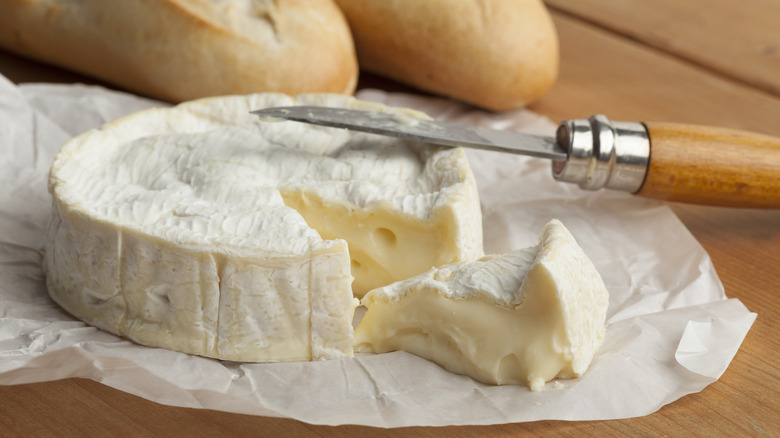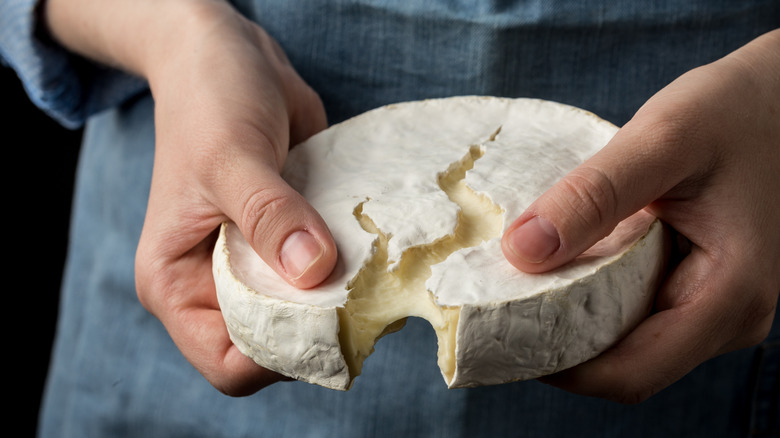Camembert Cheese May Be Going Extinct. Here's Why
Few cheeses are as universally loved as French Camembert. That's why millions will be devastated that the very existence of beloved creamy fromage is in peril. Excuse us, s'il vous plaît, while we weep into our beaujolais. Like many cheeses — such as Stilton, brie, and other various blue cheeses (otherwise known as the makings of a better cheese board) — Camembert is produced with a specific type of fungus. These fungi are what give cheeses their flavors, smells, and textures. In Camembert's case, Penicillium camemberti is responsible for the cheese's signature buttery texture, umami flavor, and aroma essence of feet. Unfortunately, the fungus is quickly becoming difficult to produce.
Regarding the situation, a study done by Paris-Saclay University has pointed the finger at production methods used to supply the increasing demand for the cheese. About a century ago, cheesemakers discovered a strain of fungi that produced evenly-colored brie and Camembert cheeses. Prior to this, the cheeses were made from Penicillium biforme, which resulted in an array of colors, flavors, and aromas. Because this newly-found uniformity was desirable, it became the sole strain cheesemakers used for production.
The problem is that Penicillium camemberti cannot reproduce on its own; instead, cheesemakers have to clone it. But, recently, the bacterium strain has developed mutations, making it harder to clone; thus, the supply has diminished drastically, putting not only Camembert in danger but brie and certain blues as well — although it appears that the former is particularly at risk.
What is Camembert?
Camembert is a soft cheese made from cow's milk that originated in Normandy and has been produced there since the 18th century. It's shaped into round discs and is covered with a white rind, which is further coated with an ivory mold. Ideally, the cheese is enjoyed at room temperature — at which point, it begins to 'weep' or gradually droop and melt, giving it an enticing look that begs to be slathered on a chunk of fresh baguette with ham and arugula.
Camembert is, visually, very similar to brie but the latter predates the former by about a thousand years. The two have similar flavors, but Camembert is described as earthier than brie, with a pronounced mushroom flavor that deepens with age. Mild, and perfect on its own or when paired with bread and a crisp wine, Camembert is wildly popular in its native France as well as around the world. It's this adoration and ensuing demand that has put a strain on the fungi strain used to make the cheese.
Even though you'll never find real brie in the United States, the kinds that you will find are great substitutions for Camembert, as are Reblochon, Brillat-Savarin, and Saint-André. To a degree, chevre, or soft goat cheese, makes a suitable substitute, but it is noticeably tangier than Camembert. These are all cheeses to consider if you start to see less of Camembert, but, it turns out, not everyone is worried about a shortage.
Fear mongering for cheesemongers?
Some wonder if the fear of imminent Camembert extinction is being exploited by the media. Fifth-generation cheesemaker and director general of Les fromageries de Normandie, Bruno Lefèvre, told CNN, "I have made all kinds of Camembert, from more traditional ones to the more industrial ones, [and] I have never encountered issues with my fungus." He went on, "This study has been widely reported by the media. Maybe the researchers were trying to make us cheesemakers panic, but so far they have not succeeded."
Even the scientists and researchers of the Paris-Saclay University study themselves have stressed that their findings should only encourage proactive preparation for the industry's future, not necessarily harbor assumptions that Camembert will suddenly disappear any day now. Ultimately, the cheese-eaters of the world will have to place their faith in the great minds of the cheesemakers and trust in their ability to conquer this latest danger, however serious it may be.



